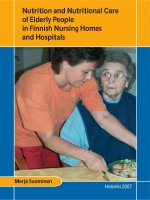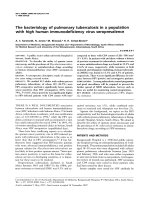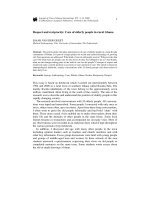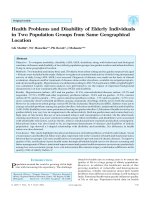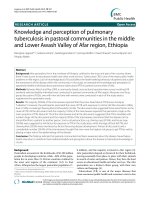Health Problems and Disability of Elderly Individuals in Two Population Groups from Same Geographical Location docx
Bạn đang xem bản rút gọn của tài liệu. Xem và tải ngay bản đầy đủ của tài liệu tại đây (36.97 KB, 6 trang )
© JAPI • VOL. 54 • JULY 2006 www.japi.org 539
Original Article
Health Problems and Disability of Elderly Individuals
in Two Population Groups from Same Geographical
Location
GK Medhi*, NC Hazarika**, PK Borah*, J Mahanta***
Abstract
Objective : To compare morbidity, disability (ADL-IADL disability) along with behavioral and biological
correlates of diseases and disability of two elderly population groups (tea garden workers and urban dwellers)
living in same geographical location.
Methods : Two hundred and ninety three and 230 elderly from urban setting and tea garden respectively aged
> 60 years were included in the study. Subjects were physical examined and activity of daily living instrumental
activity of daily living (ADL-IADL) was assessed. Diagnosis of diseases was made on the basis of clinical
evaluation, diagnosis and/or treatment of diseases done earlier elsewhere, available investigation reports,
and electrocardiography. Hypertension was defined according to JNC-VI classification. BMI (weight/height
2
)
was calculated. Logistic regression analysis was performed to see the impact of important background
characteristics on non-communicable diseases (NCD) and disability.
Results : Hypertension (urban - 68% and tea garden - 81.4%), musculoskeletal diseases (urban - 62.5% and
teagarden - 67.5%), COPD and other respiratory problems (urban - 30.4% and tea garden - 32.2%), cataract
(urban 40.3% and tea garden - 33%), gastro-intestinal problems (urban - 13% and tea garden - 6.5%) were
more commonly observed health problems among community dwellings elderly across both the groups.
However in contrast to urban group, serious NCDs like Ischaemic Heart Disease (IHD), diabetes were yet to
emerge as health problems among tea garden dwellers. Infectious morbidities, undernutrition and disability
(ADL-IADL disability) were more pronounced among tea garden dwellers. Utilization of health service by tea
garden elderly was very low in comparison to the urban elderly. Both tea garden men and women had very
high rates of risk factors like use of non-smoked tobacco and consumption of alcohol. On the other hand,
smoking and obesity was more common in urban group. Most morbidities and disabilities were associated
with identifiable risk factors, such as obesity, tobacco (smoked and non-smoked) and alcohol consumption.
Educational status was also found to be an important determinant of diseases and disability of elderly
population. Age showed a J-shaped relationship with disability and morbidity. Sex difference in health
status was also detected.
Conclusion : This study highlights the physical dimension of health problems of elderly individuals. Social
circumstances and health risk behaviours play important role in the variation of health and functional status
between the two groups. Life-style modification is warranted to prevent onset of chronic diseases. To improve
quality of life, rectification of poor health status through affordable health service for disease screening and
better management of illness, nutritional improvement and greater health awareness are necessary particularly
among low socio-economic group. Low-cost intervention like cataract surgery could make a difference in the
quality of life of elderly Indian. ©
ahead for health care in coming years is to ensure the
quality of life to a large group of elderly population.
However, to address the healthcare needs of this
growing numbers of vulnerable and heterogeneous
population, reliable information about their health
problems from different social settings is still lacking in
India. Functional health status greatly influences quality
of life at old age. Population based data on health
*Research Officer,; **Deputy Director; ***Director, Research
Officer, Regional Medical Research Centre, NE Region, ICMR,
Dibrugarh. Received : 19.5.2004; Accepted : 20.4.2006
INTRODUCTION
P
opulation around the world is growing old at high
rate with increasing life-expectancy. The challenge
540 www.japi.org © JAPI • VOL. 54 • JULY 2006
problems, functional status, behavioural risk factors,
healthcare utilization, social circumstances are
imperative for public health intervention with elderly
people. Variation may occur in the health and quality of
life among different groups of elderly population even
from the same geographical region due to these extrinsic
factors,
1,2
which need to identify for properly addressing
health needs of elderly. Tea is an important agro-industry
of India. Manual workers form more than 90% of total
adult population irrespective of sex. However their active
life ends with superannuation at 58 years. Hence, after
active manual work for long years of life, disability after
60 years should be different than those living an easy
life in urban setting.
The present paper compared the health problems and
disability of two community dwelling elderly groups
from same locality of Dibrugarh District, Assam, India
in the light of behavioural risk factors, educational status
and utilization of health services.
MATERIAL AND METHODS
A cross-sectional community based study was
conducted in two different groups of elderly population
(60 year and above) in Dibrugarh District of Assam, India
during the study period from 2002 to 2003. The study
comprised of 523 geriatric persons from both the settings.
The first group consisted of 293 (male - 181 and female
- 112) elderly persons from an urban setting among a
population of about 1.3 lakhs. Four wards and two
adjoining localities were selected randomly for the study.
The second groups of 230 (male - 101 and female -
129) geriatric persons were drawn from a community
predominantly engaged in tea industry mainly as manual
labourer. The population of tea garden community in
the district is about 2 lakhs scattered over 138 tea
gardens. All these subjects were once engaged as labourer
in tea industry and now retired from work due to age.
Data was collected from 8 randomly selected tea gardens
of the district by house-to-house visit. A total 230 geriatric
persons participated in the study.
The predesigned and pre-tested questionnaire was
used to collect the data. The questionnaire included
information on socio-demographic variables,
behavioural factors (e.g. smoking, use of non-smoked
tobacco, alcohol consumption), past and present illness
including information on utilization of health services.
Designated clinicians examined all the subjects who
volunteered to participate in the study. Diagnosis of
diseases was made on the basis of clinical presentation,
laboratory findings consistent with the specific disease,
treatment by a competent medical person.
Standard definition of diseases was used for
diagnosing health problems. The diagnostic criteria used
for defining some health conditions frequently
encountered among geriatric persons are as follows - i)
Hypertension: SBP ≥ 140 or DBP ≥ 90 (JNC VI
classification) or treatment with anti-hypertensive drugs,
ii) Diabetes: Known diabetes (self-reported) or fasting
blood sugars level ≥ 120 mg/dl
2
(blood collected after an
overnight fast of ≥ 10 hours,
3
iii) Chronic obstructive
airway diseases (COPD) : Respiratory symptoms of
cough and expectoration of sputum with or without
wheeze lasting for total duration of ≥ 3 months for 3
consecutive years or more,
4
iv) Cataract : Visible lenticular
opacity or history of cataract operation, vii) Pulmonary
tuberculosis : Report of sputum positivity for acid-fast
bacilli or radiological evidence or treatment under DTC
or garden hospital. Moreover self-reported information
of diagnosis or treatment of ischaemic heart disease or
anginal pain by a qualified medical practitioner was
also recorded.
Functional status of individuals was assessed in terms
of their ability to perform seven important activities of
daily living-instrumental activity of daily living (ADL-
IADL) without help e.g. dressing, transferring from bed,
toileting or taking bath, preparation of food, eating,
shopping and walking.
Height and weight of the subjects were measured using
standard procedures. The weight was measured using
SECA balance with minimum of cloths to the nearest of
100 gms and height was measured using an
anthropometric rod to the minimum of 0.5 cm. Body mass
index (BMI : weight in kg/height in meters
2
) was
calculated from heights and weights. A value ≤ 18.5 is
considered as a cut-off point for chronic energy
deficiency (CED) or undernutrition (thinness), while BMI
≥ 25 is considered as overweight or obese.
Prevalence of diseases in both groups separately was
calculated. Logistic regression [exp (b)] analysis was
performed controlling the effect of other potential risk
factors to detect the relationship between some
background characteristics and diseases or disability
(ADL-IADL disability). Statistical analysis was done
suing SPSS software. Odds ratio [exp (b)] for each
category of independent variable obtained from the
analysis indicated the odds of having the specific disease
condition or disability compared to the reference
category (odds ratio one) after controlling the effect of
other important variables.
RESULTS AND ANALYSIS
The mean age for urban group was 67.1 (SD ± 7.03)
and 66.47 (SD ± 6.39) for tea garden group. Some of the
important background characteristics of subjects are
presented in the Table 1.
Table 2 shows that prevalence of health problems
including ADL-IADL disability in both groups. Chronic
and non-communicable conditions like hypertension,
musculoskeletal problems, cataract and respiratory
conditions were commonly observed health problems
among geriatric individuals of both the groups. Diabetes,
ischaemic heart disease, obesity were mainly problems
© JAPI • VOL. 54 • JULY 2006 www.japi.org 541
in urban geriatric population. Self reported information
indicates that 5.46% (n=16) urban elderly were under
treatment for ischaemic heart disease or anginal pain as
against none from tea garden. Hypertension was more
prevalent in tea garden group (81.4%) in comparison to
urban group (68.8%). Musculoskeletal problems,
respiratory problems were found to be marginally higher
in tea garden group.
75.9% tea garden geriatric individuals were
undernourished whereas in urban counterpart only
Table 1 : Distribution of the subjects according to some important background characteristics
Background Urban (N=293) Tea garden (N=230)
characteristics Male (%) Female (%) Male (%) Female (%)
Age
60-65 (1) 63 (34.8) 58 (51.8) 40 (39.6) 37.2 (37.2)
65-70 (2) 54 (29.8) 28 (25.0) 21 (20.8) 31.0 (31.0)
70-75 (3) 34 (18.8) 11 (9.8) 21 (20.8) 24.8 (24.8)
> 75 (4) 30 (16.6) 15 (13.4) 19 (18.8) 7.0 (7.0)
Sex 181 (61.8) 112 (38.2) 101 (43.9) 129 (56.1)
Education
Illiterate 20 (11) 34 (30.4) 89 (88.1) 123 (95.3)
Primary 22 (12.2) 32 (28.6) 7 (6.9) 6 (4.7)
Highschool 35 (19.3) 28 (25.0) 4 (4) Nil
College 104 (57.5) 18 (16.1) 1(1) Nil
Smoking
Current smoker’s 43 (3.8) 2 (1.8) 20 (19.8) 6 (4.7)
Non-smoker 138 (76.2) 110 (98.2) 81 (80.2) 123 (95.3)
Non-smoked Tobacco use
Users 38 (21) 23 (20.5) 78 (77.2) 104 (80.6)
Non-user 143 (79) 89 (79.5) 23 (22.8) 25 (19.4)
Alcohol consumption
Current consumption 44 (24.4) 13 (11.6) 73 (72.3) 90 (69.8)
Non-consumption 137 (75.7) 99 (88.4) 28 (27.7) 39 (30.2)
Health service utilization
Yes 72 (39.8) 42 (37.5) 12 (11.9) 7 (5.4)
No 109 (60.2) 70 (62.5) 89 (88.1) 122 (94.6)
Total 181 112 101 129
Table 2 : Health problems of elderly in both settings
Disease conditions Urban (a=293) Tea garden (n=230)
Male (%) Female (%) Total (%) Male (%) Female (%) Total (%)
n=180 n=112 n=292 n=102 n=129 n=129
Hypertension 125/179 (69.8) 73/109 (67) 198/288 (68.8) 104/125 (83.2) 71/90 (78.9) 175/215 (81.4)
Cataract 71 (39.2) 47 (42) 118 (40.3) 30 (29.7) 46 (35.7) 76 (33)
Musculoskeletal 107 (59.1) 76 (67.9) 183 (62.5) 69 (67.6) 87 (67.4) 156 (67.53)
COPD 16 (8.8) 6 (5.4) 22 (7.5) 10 (9.9) 8 (6.2) 18 (7.8)
* Respiratory problems 58 (32) 31 (27.7) 89 (30.4) 40 (40) 34 (26.4) 74 (32.2)
Diabetes 36 (19.9) 15 (13.4) 51 (17.4) 1 (1) 1 (0.8) 2 (9)
Stroke/Paralysis 8 (4.4) 3 (2.7) 11 (3.8) 8 (7.9) 1 (0.8) 9 (3.9)
**Major neurological 12 (6.6) 11 (9.8) 23 (7.8) 18 (17.8) 13 (10.1) 31 (13.5)
conditions
Neoplasm 1 (0.5) Nil 1 (0.34) 1 (1) 1 (0.8) 2 (0.9)
Pulmonary TB Nil Nil Nil Nil 2 (1.6) 2 (0.9)
Leprosy Nil Nil Nil 1 (1) 1 (0.8) 2 (0.9)
Filariasis Nil Nil Nil 2 (2) Nil 2 (0.9)
Diarrhea 4 (2.2) 2 (1.8) 6 (2.1) 4 (4) 6 (4.7) 10 (4.4)
Skin infection/scabies 5 (2.8) 2 (1.9) 6 (2.1) 9 (9) 6 (4.7) 15 (6.5)
Other GIT problems 26 (14.4) 12 (10.7) 38 (13) 4 (3.9) 11 (8.5) 15 (6.5)
Injury and fall 6 (3.3) 7 (6.3) 13 (4.4) 5 (5) Nil 5 (2.2)
Eye conditions 9 (5) 6 (5.4) 15 (5.1) 7 (6.9) 9 (7) 16 (7)
Genito-urinary 8 (4.4) 7 (6.3) 15 (5.1) 2 (2) 8 (6.2) 10 (4.4)
Undernutrition 35/178 (19.7) 32/106 (30.2) 67/284 (23.6) 57/81 (70.4) 91/114 (79.8) 148/195 (75.9)
Obesity 30/178 (16.9) 25/106 (23.6) 55/284 (19.4) 1/81 (1.2) 2/114 (2.8) 3/195 (1.5)
ADL-IADL disability 36 (19.9) 23 (20.5) 59 (20.1) 29 (28.7) 35 (27.1) 64 (27.8)
*Also includes COPD; **Also includes paralysis/stroke
542 www.japi.org © JAPI • VOL. 54 • JULY 2006
Table 3 : Results of logistic regression analysis for determinant of diseases and health conditions
Morbidities
Background Hypertension Diabetes* Cataract Respiratory Locomotion Undernut- Obesity*
characteristics problems problems rition
(Thinness)
Age
60-65 1
a
11
a
1
a
1
a
11
65-70 1.248 0.751 1.873
a
1.795
b
1.526 0.978 0.734
70-75 2.118
b
0.770 2.538
a
2.458
a
2.671
a
0.741 1.018
75 and above 3.249
a
2.128 5.243
a
6.764
a
6.808
a
0.913 0.106
b
Sex
Male 1111111
Female 1.242 0.729 0.983 0.792 1.382 1.231 2.909
a
Place
Urban 1 1111
Tea garden 1.281 0.250 1.061 0.930 5.142
a
Education
College 1 1 1
a
111
a
7.190
a
Highschool 0.770 0.596 2.481
a
1.925 0.940 1.607 3.980
b
Primary 0.997 0.4592.527
a
1.930 0.974 4.694 1.535
Illiterate 0.982 0.251
b
3.552
a
2.684
a
0.933 6.924
a
1
a
Smoking
Non-smoker 1111111
Current smoker 0.944 0.481 0.959 2.706
a
0.927 1.519 1.465
BMI
<18.5 0.689 0.537 1.533 1.386 1.640
b
18.5-25 1 1
b
111
25> 1.739 2.353
b
0.910 0.799 1.128
* - Only urban subjects are included in the analysis;
a
- significant at <1% level;
b
- Significant at <5% level
19.4% were undernourished. Contrary to 19.4% of urban
subjects only 1.5% tea garden subjects were obese. 2.6%
tea garden geriatric individuals had either of the three
infectious morbidities viz. tuberculosis, leprosy or
filariasis. 6.5% tea garden individuals also suffered from
skin sore, which was high compared to urban group
(2.1%).
20.1% urban and 27.8% tea garden subjects
experienced problems in self-maintenance of ADL-IADL.
Table 3 and Table 4 shows the results of a logistic
regression analysis to find out the impact of selected
background characteristics on some of the important
disease conditions and ADL-IADL disability of the
geriatric population.
Tea garden background was found to be an important
independent predictor of hypertension. Tea garden
elderly was 5.1 times more likely to be undernourished
than urban elderly. In separate analysis of urban data
less educational attainment was found to be an
important predictor of undernutrition and ADL-IADL
disability.
As the age advances the odds of various diseases and
ADL-IADL disability also increases significantly
confirming a J-shaped relationship between age and
different geriatric morbidieties. Female sex was found to
be independent predictor of hypertension, locomotion
problems, undernutrition and overweight. However
male sex had an independent influence on IHD,
respiratory diseases, and ADL-IADL disability.
Cigarette smokers were 2.7 times more likely to have
respiratory diseases than those of non-smokers. Similarly
consumption of alcohol and use of non-smoked tobacco
were found to be risk factors of hypertension.
BMI more than 25 was risk factor for hypertension
and diabetes. On the other hand risk of respiratory
diseases and cataract increased below a BMI of 18.5.
Risk for musculoskeletal problems was found to be
higher in both extremes of physical status. The higher
risk of diseases to the both extremes of BMI suggests a U-
shaped relationship of diseases with BMI. BMI less 18.5
was also found to be a significant predictor of ADL-
IADL disability among geriatric individuals.
38.9% (n=114) urban and 8.3% (n=21) tea garden
elderly used health services during last one month. Use
of health service was found to be significantly higher
among those with a higher educational attainment than
less educated.
DISCUSSION
If the increase in life expectancy has a downside, it is
the exposure of risk to age-related chronic disorders.
5
As expected the study shows that irrespective of place
of living aging is associated with higher burden of
chronic and non-communicable diseases and poorer
physical functioning which adversely affect the well-
being of older people. The common health conditions of
elderly were hypertension, musculoskeletal problems,
cataract, COPD and other respiratory problems. Survey
© JAPI • VOL. 54 • JULY 2006 www.japi.org 543
carried out by National Sample Survey Organization
(NSSO) and some other population-based studies from
different parts of the country also reported higher burden
of chronic health conditions in elderly population.
6-8
Burden of hemiplegia presumed to be vascular origin
was higher in both groups compared to previous
statistics from India.
9
High prevalence of hypertension
and low level of awareness and treatment of
hypertension might have contributed in the higher
prevalence of vascular complication.
10,11
Burden of non-
communicable diseases like diabetes was higher in
urban group and comparable to previous report.
12
The present findings show that functional
dependence of geriatric individuals becomes a more
important concern manly after the age of 75. However,
the big difference of adjusted and unadjusted odds ratio
of ADL-IADL disability in relation to age suggest that
the functional status of elderly individuals can be
improved to a large extent by removing those factors.
Elderly women were more vulnerable to undernutrition,
which could be due to their greater socio-economic
marginalization. Similarly, female were more likely to
Table 4 : Logistic regression analysis to show the
association between some background characteristics and
ADL-IADL disability*
Variables Exp (B)
Age (Years)
60-64 1
b
(1)
c
65-69 1.226
b
(2.72)
c
70-74 2.268
b
(2.96a)
c
>=75 4.504
a
(8.53a)
c
Sex
Male 1
Female 0.985
Place
Urban 1
Tea garden 0.859
Education
College and above 1
High school 2.657
b
Primary 2.583
Illiterate 3.469
a
Smoking
Current smoker 1
Non smoker 1.186
Non-smoked tobacco
No 1
Yes 1.803
Alcohol
No 1
Yes 0.674
BMI
< 18.5 1.295
18-5-24.99 1
>=25 1.593
*(Also adjusted for health conditions which likely to influence
ADL-IADL e.g. Cataract, Hemiplegia/other major neurological
conditions, respiratory conditions, musculoskeletal conditions);
a
- Significant at <1% level;
b
- Significant at <5% level;
c
- Figure in
the parenthesis is the unadjusted odds ratio
have musculoskeletal problem than male, which perhaps
reflect harder life faced by females who never retire from
household work unless totally disabled.
13
Although in
bi-variate analysis no gender difference was detected in
disability, yet in logistic regression analysis after
eliminating the influence of other factors, risk of
disability increased in male sex in the present study.
Independent effects of social factor like educational
attainment and other well-established NCD risk factors
like tobacco use (smoked and non-smoked), alcohol
consumption, BMI on some selected diseases and
disability was clearly visible in the study, which indicates
that health at old age is modifiable in the study group.
Prevalence of common risk factors of NCDs such as
smoking and obesity, in urban population, was high.
With urbanization, there is a marked increase in
consumption of energy rich foods, a decrease in energy
expenditure (through less physical activity),
14
which
results in obesity. Unpublished report indicates that
prevalence of physical inactivity was very high in the
same urban population where study was carried out.
Presence of these risk factors of NCDs seems contributed
to the prevalence of ischaemic heart diseases, diabetes
and hypertension. Moreover diabetes and hypertension
themselves also have interactive action in IHD. Burden
of undernutrition was also found to be equally important
in urban population, mainly among less educated
elderly. The study also provides evidence that even
within urban elderly population there was striking
differences in health status in terms of functional health
between educated and less educated. The increased level
of health awareness for remaining fit and healthy, higher
utilization of health services for disease screening and
treatment by higher educated probably influenced
positively for their better functional health status and
the reverse was probably true in case of less educated.
In sharp contrast to the sedentary lifestyle in urban
population, life in tea garden industry involves hard
physical activity due to their job demand. Moreover, the
tea garden population is characterized by very high level
of illiteracy and also lagging behind rest of population
of the state in other aspects of socio-economic
development. The lower socio-economic condition of tea
garden population was perhaps reflected in the high
magnitude of preventable conditions like undernutrition
and infectious morbidities like skin sores, scabies,
tuberculosis, leprosy, filariasis and sequelae of these
diseases. Some recent health surveys conducted in tea
garden population also showed that undernutrition,
infectious morbidities were high in this population.
15,16
Elderly people belonging to tea garden are of lower socio-
economic status appears to be at higher risk related to
poor dietary intake. Evidence suggests that loss of lean
body mass predicts functional status especially in the
elderly. Changes in body composition as determined
anthropometrically may be extremely helpful in
544 www.japi.org © JAPI • VOL. 54 • JULY 2006
predicting the ability to live independently.
17
Undernutrition compounded with illiteracy could
probably be responsible for higher prevalence of ADL-
IADL disability among tea garden elderly compared to
urban elderly. Further low utilization rate of health
services by tea garden elderly could also adversely affect
health status.
Consumption of locally prepared alcohol and use of
non-smoked tobacco was rampant in tea garden
population. Hypertension, an important NCD in tea
garden, showed association with consumption of
alcohol and use of non-smoked tobacco, which was in
conformity with earlier reports from tea garden.
10,11
This profile highlights the physical dimension of
health of the elderly and shows evidence that socio-
demographic factors and health risk behaviour
accounted for much of the variation of health and
functional status between two groups. Ideally,
intervention at modifiable risk factors is required for
keeping at bay illness of chronic nature, yet there is also
need for various medical interventions for improving
the health status of elderly population.
Acknowledgement
Authors wish to express thanks to Mr. M Chetia of
this centre for his active co-operation in completing this
study.
REFERENCES
1. Yadava KN, Yadava SS, Vajpeyi DK. Study of aged
population and associated health risks in rural India. Health
Policy Plan 1994;9:331-6.
2. Kumar KV, Sivan YS, Reghu JR, Das R, Kutty VR. Health of
the elderly in a community in transition: a survey in
Thiruvananthapuram City, Kerala, India. Int J Aging Hum
Dev 1997;44:293-315.
3. Gupta HL, Yadav M, Sundarka MK, Talwar V, Saini M, Garg
P. Study of Health Problems in Asymtomatic Elderly
individuals in Delhi. J Assoc Physicians India 2002;50:792-5.
4. Debidas Ray, Abel R, Selvaraj KG. A 5 year prospective
epidemiological study of chronic obstructive pulmonary
disease in rural south India. Indian J Med Res 1995;101:
238-44.
5. Cassel CK. Successful aging. How increased life expectancy
and medical advances are changing geriatric care. Geriatrics
2001;56:35-9.
6. National Sample Survey Organization (NSSO)
“Sarvekshana”, Vol XV, Nos. 1-2, Issue NO. 49, 1991.
7. Chacko A, Joseph A. Health problems of the elderly in rural
south India. Indian Journal of Community Medicine 1990;15:
70-3.
8. Khokhar A, Mehra M. Life style and morbidity profile of
geriatric population in an urbans community of Delhi. Indian
J Med Sci 2001;55:609-15.
9. Dalal PM. Strokes in the elderly: prevalence, risk factors and
the strategies for prevention. Indian J Med Res 1997;106:
352-32.
10. Hazarika NC, Biswas D, Narain K, Kalita HC, Mahanta J.
Hypertension and its risk factors in tea garden workers of
Assam. National Medical J India 2002;15:63-8.
11. Hazarika NC, Biswas D, Mahanta J. Hypertension in Elderly
population of Assam. J Assoc Physicians India 2002;51:63-8.
12. Shan B, Prabhakar AK. Chronic morbidity profile among
elderly. Indian J Med Res 1997;106:265-72.
13. Bali AP. Socio-economic status and its relationship to
morbidity among elderly. Indian J Med Res 1997;106:349-60.
14. Yusuf S, Reddy S, Ounpuu S, Anand S. Global burden of
cardiovascular diseases part I: General considerations, the
epidemiologic transition, risk factors, and impact of
urbanization. Circulation 2001;104:2746-53.
15. Biswas D, Hazarika NC, Doloi P, Mahanta J. Study on
nutritional status of tea garden workers of Assam with
special emphasis on body mass index (BMI) and central
obesity. J Hum Ecol 2002;13:299-302.
16. Morbidity profile and dimension of health problems among
tea garden workers of Assam - A report of ICMR extramural
project, 2004:1-37.
17. Physical status : The use and interpretation of anthropometry.
WHO technical report Series 854; WHO, Geneva 1995:392.
DOCTOR 2004 Medical Software
DOUBLE LICENSE FOR SINGLE ORDER (offer extended till July 31 2006)
CLINICAL : Case sheets, speciality sheets, Inpatient, ICU, Lab, PDR, Auto Casesummary, Certificates,
letters, USS, X-ray, Pathology, Endoscopy, Echo, Proc. reports, very little typing needed. Prescription
Autodose, Allergy, disease-contraindication, interaction alert, Fonts option (Hindi Tamil etc) Overdose
treatment, Ther. level, dose in organ failures Store Recall at a single click.
ADMINISTRATIVE : Appointment schedular; OP Card, Pt. List, Statisics, Finance billing; salary, room,
manpower management; Drugstore, Inventory. Secure, NETWORK ready. Auto backup Store/Link photos,
X-ray, ECG, Videos; Change Header/Footer; Diet advisor-autocalory calculator
EDUCATIVE : Disease guidelines and Journal reference; Medical photographs and graphs; Patient
education videos and printouts. Widely used, Reliable. Saves Life, Time and Money.
No learning required. Hospital pack, and excl. medicine, surgery, OBG, clinic packs available.
Address : MEDISOFT, Achutha Warrier Lane, Cochin-682035. BUY NOTHING BUT THE BEST
DETAILS at : Ph 09847294414

